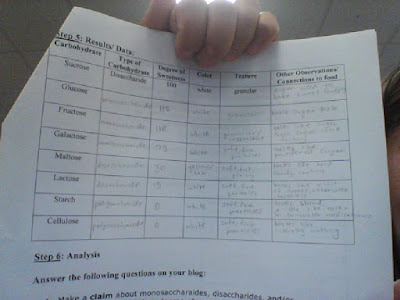When discussing degree of sweetness, it will depend on whether the sugar is a monosaccharaide, disaccharaide, or polysaccharaide. Monosaccharaides tend to be the sweetest. Polysaccharaides tend to be the least sweet, and disaccharaides are somehwere in between. The average sweetness of the three monosaccharaides (glucose, fructose, galactose) was 100. The average amount of sweetness of the disaccharaides (sucrose, maltose, lactose) was 48 1/3. The average sweetness of the polysaccharaides (starch, cellulose) was 0. As you can see, the fewer rings in a sugar molecule, the sweeter it will be.
The shape of a carbohydrate structure (monosaccharaides, dissacharaides, polysaccharaides) would change how a cell uses that specific sugar. Monosaccharaides are typically used as a primary energy source for cells. Disaccharaides are typically used as a way to create energy for the cell. Polysaccharaides are usually used as energy storage within the cell. Polysaccharaides are good for this function because they have multiple structures, so they can store a large amount of energy. Disaccharaides are only two rings, making them a good size to produce energy within. Monosaccharaides are a single ring, making them simplest to break down, allowing them to be an easy way to get energy quickly.
My group members all tasted the sugars differently and had various ratings for the degree of sweetness. Three possible explanations as to why this may have happened are as follows. Someone may not have gotten the last sugar's taste out of their mouth before tasting the next sugar. Another possibility is that someone may have tasted the sugar in a certain part of their mouth to yield different results. Another simple reason is that people just perceive sweetness degree differently. Each individual has their own opinion on what they consider very sweet or not.
Your tongue causes humans to taste, and specifically your taste buds on your tongue. As stated on the website PubMed Health, the tongue tastes by using various taste buds ion various sections of the tongue. Taste is not simply 'taste' of something, but also a combination of the smell, texture, and various other aspects. Taste papillaes on the tongue 'magnify' the taste of the foods you taste. They allow you to taste what you are consuming more intensely. Based on my findings on this website, I can now infer more specifically as to why different students ranked sugar taste differently. There are no taste buds on the center of your tongue, so if someone tasted a sugar in the center of their tongue, they would taste a low sugar amount. If someone did not taste the sugar on the taste papillaes, that may have altered their perception of how sweet the different sugars were. Generally, the placement of the sugar on the tongue would have altered how people ranked how sweet each sugar was.
Works Cited
How Does Our Sense of Taste Work? U.S. National Library of Medicine, n.d. Web. 19 Sept. 2016.
The shape of a carbohydrate structure (monosaccharaides, dissacharaides, polysaccharaides) would change how a cell uses that specific sugar. Monosaccharaides are typically used as a primary energy source for cells. Disaccharaides are typically used as a way to create energy for the cell. Polysaccharaides are usually used as energy storage within the cell. Polysaccharaides are good for this function because they have multiple structures, so they can store a large amount of energy. Disaccharaides are only two rings, making them a good size to produce energy within. Monosaccharaides are a single ring, making them simplest to break down, allowing them to be an easy way to get energy quickly.
My group members all tasted the sugars differently and had various ratings for the degree of sweetness. Three possible explanations as to why this may have happened are as follows. Someone may not have gotten the last sugar's taste out of their mouth before tasting the next sugar. Another possibility is that someone may have tasted the sugar in a certain part of their mouth to yield different results. Another simple reason is that people just perceive sweetness degree differently. Each individual has their own opinion on what they consider very sweet or not.
Your tongue causes humans to taste, and specifically your taste buds on your tongue. As stated on the website PubMed Health, the tongue tastes by using various taste buds ion various sections of the tongue. Taste is not simply 'taste' of something, but also a combination of the smell, texture, and various other aspects. Taste papillaes on the tongue 'magnify' the taste of the foods you taste. They allow you to taste what you are consuming more intensely. Based on my findings on this website, I can now infer more specifically as to why different students ranked sugar taste differently. There are no taste buds on the center of your tongue, so if someone tasted a sugar in the center of their tongue, they would taste a low sugar amount. If someone did not taste the sugar on the taste papillaes, that may have altered their perception of how sweet the different sugars were. Generally, the placement of the sugar on the tongue would have altered how people ranked how sweet each sugar was.
Works Cited
How Does Our Sense of Taste Work? U.S. National Library of Medicine, n.d. Web. 19 Sept. 2016.

Comments
Post a Comment